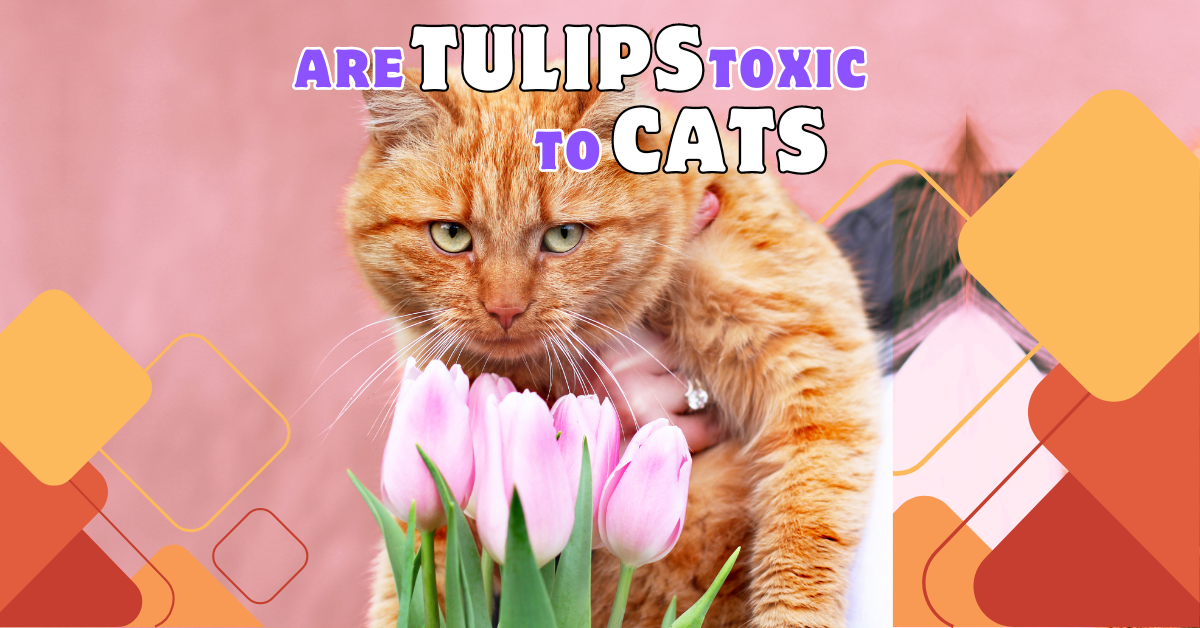Tulips are a beloved springtime flower, known for their vibrant colors and elegant appearance. However, if you’re a cat owner, it’s essential to be aware of the dangers that tulips can pose to your feline friends. The question many cat owners ask is: are tulips toxic to cats? Tulips contain toxic compounds that can be harmful, or even fatal, to cats if ingested. In this article, we’ll cover 5 critical facts about tulip toxicity in cats, what symptoms to look for, and how to prevent tulip poisoning in your home or garden.
Are Tulips Toxic to Cats? Understanding the Dangers
Yes, tulips are toxic to cats. Tulips belong to the Liliaceae family, a group of plants known for their toxicity to pets, particularly cats. The primary toxins in tulips are tulipalin A and tulipalin B, which are found in all parts of the plant but are most concentrated in the bulb. When a cat ingests any part of a tulip, the question are tulips toxic to cats? becomes critically relevant, as it can lead to a range of symptoms, from mild gastrointestinal upset to more severe reactions such as difficulty breathing and heart irregularities.
Why Are Tulips Harmful to Cats?
Tulipalin A and B are allergenic lactones, which are toxic to cats if consumed. These chemicals interfere with the normal functioning of the cat’s digestive and nervous systems, leading to symptoms such as vomiting, diarrhea, and lethargy. The toxins can also cause oral irritation, making it painful for the cat to eat or drink.
While tulips are not as deadly as other plants like lilies, the question are tulips toxic to cats? still warrants serious consideration. They can still cause serious health problems for cats, especially if the cat consumes the bulb, where the concentration of toxins is highest.
Symptoms of Tulip Poisoning in Cats
If your cat ingests any part of a tulip, you’ll need to be vigilant for signs of tulip poisoning. The symptoms can vary depending on the amount of the plant consumed, but common indicators include:
1. Gastrointestinal Symptoms
- Vomiting: This is often one of the first signs that a cat has ingested something toxic. If your cat is vomiting after being near tulips, tulip poisoning could be the cause.
- Diarrhea: Tulip toxins can cause irritation in the digestive system, leading to diarrhea, which can sometimes be severe.
- Drooling: Excessive salivation is a common reaction in cats when they ingest tulips, as the toxins cause oral irritation.
2. Behavioral Changes
- Lethargy: A poisoned cat may become unusually sluggish and show little interest in its surroundings.
- Depression: Your cat may appear depressed or disoriented, often lying down for long periods without engaging in its usual activities.
3. Neurological Symptoms
- Tremors: In more severe cases, cats may experience tremors or shaking due to the impact of tulipalin on their nervous system.
- Seizures: While rare, seizures may occur if a cat has ingested a large quantity of tulip toxins.
4. Difficulty Breathing
- In extreme cases, tulip poisoning can affect a cat’s respiratory system, making it difficult for the cat to breathe. This is a medical emergency and requires immediate veterinary attention.
What to Do If Your Cat Eats Tulips: Immediate Steps
If you suspect that your cat has eaten tulips, it’s essential to act quickly. Here are the immediate steps you should take to ensure your cat gets the care it needs:
1. Remove the Cat from the Area
If your cat is near tulips, immediately remove it from the area to prevent further ingestion. Check to see if there are any signs of the plant missing or chewed up.
2. Call Your Veterinarian
Contact your vet as soon as possible and explain the situation. The vet may ask you to monitor your cat for specific symptoms or advise you to bring the cat in for treatment. Always err on the side of caution—early intervention can prevent more severe health issues.
3. Monitor Symptoms
While waiting for veterinary advice or transport, keep a close eye on your cat’s behavior and physical condition. Take note of any symptoms such as vomiting, lethargy, or tremors, as this information will help the vet make a diagnosis and treatment plan.
4. Do Not Induce Vomiting
Unless specifically instructed by a veterinarian, do not attempt to induce vomiting in your cat. Doing so without proper guidance can cause further harm, especially if the plant material is irritating the esophagus or airways.
5. Bring a Sample of the Plant
If possible, bring a sample of the tulip with you to the vet. This can help the vet quickly confirm the cause of poisoning and decide on the most effective treatment.
Why Are Tulip Bulbs More Toxic Than the Flowers?
While all parts of the tulip plant contain toxins, tulip bulbs are particularly dangerous for cats. The bulbs contain a higher concentration of tulipalin A and B, making them more toxic than the leaves or flowers. This can be especially concerning if you have tulip bulbs stored indoors for planting or if you have outdoor cats that might dig up bulbs from the garden.
The Risks of Bulb Ingestion
Cats that dig in the garden or explore plant pots are at the highest risk of tulip bulb ingestion. Bulbs are also more attractive to cats because they are often coated with fertilizers or other substances that may have a scent or texture that cats find appealing.
Ingesting even a small amount of a tulip bulb can lead to severe gastrointestinal distress or more serious complications, such as tremors and difficulty breathing.
How to Prevent Tulip Poisoning: Cat-Proofing Your Garden and Home
Prevention is key when it comes to protecting your cat from the dangers of tulip poisoning. Fortunately, there are several steps you can take to cat-proof your home and garden.
1. Remove Tulips from Your Home
The safest option is to remove tulips from any areas your cat can access. This includes not only potted tulips inside the home but also any bouquets or floral arrangements that include tulips. If tulips are a must-have, consider placing them in rooms that are off-limits to your cat.
2. Use Raised Garden Beds or Planters
If you have tulips in your garden, consider using raised garden beds or planters that your cat cannot easily reach. This can help prevent your cat from digging up bulbs or chewing on plants.
3. Cover Bulbs with Netting
For outdoor tulip bulbs, use netting or chicken wire to cover the soil where bulbs are planted. This will deter your cat from digging them up and coming into contact with the toxic parts of the plant.
4. Offer Safe Alternatives
If your cat enjoys chewing on plants, consider providing them with safe, non-toxic alternatives like cat grass or catnip. These plants are safe for cats to nibble on and can help redirect their attention away from harmful plants like tulips.
Tulip Alternatives: Safe Plants for Cats
If you love flowers but want to keep your home and garden safe for your furry friends, consider planting cat-friendly alternatives. Here are some beautiful, non-toxic plants that are safe for homes with cats:
1. African Violets
With their vibrant purple flowers, African violets add color to your home without posing any danger to your pets.
2. Spider Plants
Spider plants are not only safe for cats, but they are also easy to care for and thrive in most indoor environments.
3. Boston Ferns
Boston ferns are lush, green, and completely safe for cats, making them an excellent choice for hanging planters or indoor greenery.
4. Marigolds
Bright and cheerful, marigolds are another cat-safe plant that can add a splash of color to your garden or home.
While we’re discussing plant safety, you might also wonder, “Are roses toxic to cats?” Make sure to check out this related article here for essential insights on how roses can affect your furry friends!
Why Are Tulips Harmful to Cats?
Tulipalin A and B are allergenic lactones, which are toxic to cats if consumed. These chemicals interfere with the normal functioning of the cat’s digestive and nervous systems, leading to symptoms such as vomiting, diarrhea, and lethargy. The toxins can also cause oral irritation, making it painful for the cat to eat or drink.
While tulips are not as deadly as other plants like lilies, they can still cause serious health problems for cats, especially if the cat consumes the bulb, where the concentration of toxins is highest.
This insertion serves as a smooth transition into the internal linking while remaining relevant to the topic of pet safety regarding flowers. If you need further modifications or additions, feel free to ask!
Tulip Poisoning Treatment: What Your Vet Will Do
If your cat is diagnosed with tulip poisoning, your vet will take steps to minimize the impact of the toxins and help your cat recover.
1. Induced Vomiting or Activated Charcoal
In some cases, your vet may induce vomiting to remove the tulip toxins from your cat’s stomach. Alternatively, they might administer activated charcoal to prevent the toxins from being absorbed into the bloodstream.
2. IV Fluids
Cats that have experienced severe vomiting or diarrhea may become dehydrated. IV fluids can help rehydrate your cat and flush out toxins more quickly.
3. Medications
If your cat is experiencing pain, tremors, or other severe symptoms, the vet may prescribe medications to help stabilize your cat’s condition and prevent complications.
4. Monitoring
Your vet may choose to keep your cat under observation for a few hours to ensure that their condition improves and that no further symptoms develop. In severe cases, overnight monitoring may be necessary.
Conclusion: How to Keep Your Cat Safe from Tulip Poisoning
While tulips are beautiful flowers, they can pose a serious risk to your cat’s health. Understanding the dangers of tulip toxicity and knowing how to prevent exposure can help you keep your cat safe. By removing tulips from your home, taking steps to cat-proof your garden, and providing safe plant alternatives, you can enjoy a beautiful, pet-friendly environment. . The question are tulips toxic to cats? is crucial for all cat owners. Always act quickly if you suspect your cat has ingested tulips and seek veterinary care immediately to ensure the best outcome.
FAQs About Tulip Toxicity in Cats
- Are tulips toxic to cats?
Yes, tulips contain tulipalin A and B, which are toxic to cats if ingested. - What are the symptoms of tulip poisoning in cats?
Symptoms include vomiting, diarrhea, drooling, lethargy, and in severe cases, tremors or difficulty breathing. - Which part of the tulip is most toxic to cats?
The bulb contains the highest concentration of toxins, but all parts of the tulip can be harmful. - What should I do if my cat eats tulips?
Immediately remove your cat from the area and call your vet for advice. Do not induce vomiting unless instructed by your vet. - How can I prevent tulip poisoning in my home?
Remove tulips from areas your cat can access, use raised planters for outdoor tulips, and cover bulbs with netting to deter digging. - Are there safe plant alternatives for homes with cats?
Yes, plants like African violets, spider plants, and Boston ferns are non-toxic and safe for cats. - How is tulip poisoning treated in cats?
Treatment may involve inducing vomiting, administering activated charcoal, providing IV fluids, and medications to alleviate symptoms. - Are tulips toxic to other pets?
Yes, tulips can be toxic to dogs and other animals as well. - Can cats recover from tulip poisoning?
With prompt veterinary treatment, most cats recover fully from tulip poisoning. - Are there other common plants that are toxic to cats?
Yes, plants like lilies, daffodils, and sago palms are also toxic to cats.

Joseph Bush is a seasoned writer and researcher with over 7 years of experience covering a wide range of general topics, from lifestyle and technology to business and current events. He is dedicated to producing fact-checked, reader-friendly content that informs, engages, and empowers readers.
Throughout his career, Joseph has followed strict editorial guidelines, relied on reputable sources, and ensured every article meets the highest standards of accuracy and clarity. His expertise spans multiple fields, allowing him to explain complex topics in a way that’s easy to understand.
Passionate about continuous learning, Joseph stays updated on industry trends and best practices to deliver trustworthy, well-rounded insights. Readers can rely on his work for its credibility, depth, and real-world relevance.




